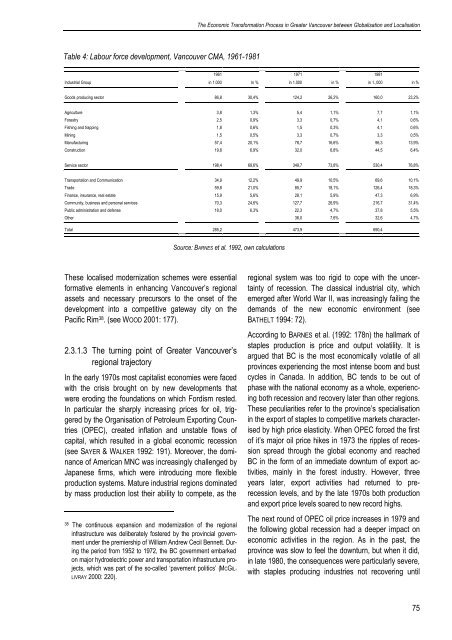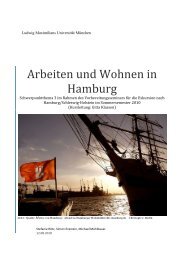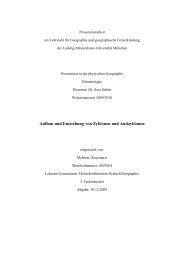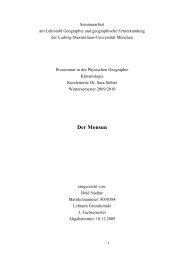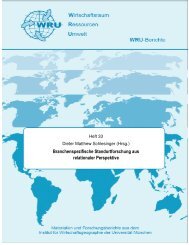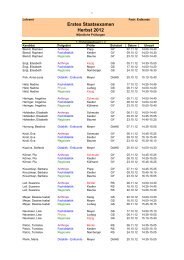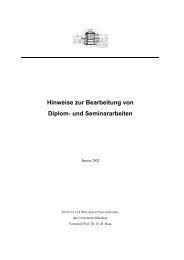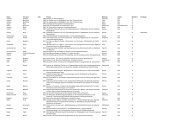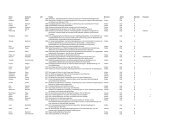Wirtschaftsraum Ressourcen Umwelt WRU-Berichte
Wirtschaftsraum Ressourcen Umwelt WRU-Berichte
Wirtschaftsraum Ressourcen Umwelt WRU-Berichte
Create successful ePaper yourself
Turn your PDF publications into a flip-book with our unique Google optimized e-Paper software.
Table 4: Labour force development, Vancouver CMA, 1961-1981<br />
These localised modernization schemes were essential<br />
formative elements in enhancing Vancouver’s regional<br />
assets and necessary precursors to the onset of the<br />
development into a competitive gateway city on the<br />
Pacific Rim 38 . (see WOOD 2001: 177).<br />
2.3.1.3 The turning point of Greater Vancouver’s<br />
regional trajectory<br />
In the early 1970s most capitalist economies were faced<br />
with the crisis brought on by new developments that<br />
were eroding the foundations on which Fordism rested.<br />
In particular the sharply increasing prices for oil, triggered<br />
by the Organisation of Petroleum Exporting Countries<br />
(OPEC), created inflation and unstable flows of<br />
capital, which resulted in a global economic recession<br />
(see SAYER & WALKER 1992: 191). Moreover, the dominance<br />
of American MNC was increasingly challenged by<br />
Japanese firms, which were introducing more flexible<br />
production systems. Mature industrial regions dominated<br />
by mass production lost their ability to compete, as the<br />
38 The continuous expansion and modernization of the regional<br />
infrastructure was deliberately fostered by the provincial government<br />
under the premiership of William Andrew Cecil Bennett. During<br />
the period from 1952 to 1972, the BC government embarked<br />
on major hydroelectric power and transportation infrastructure projects,<br />
which was part of the so-called ‘pavement politics’ (MCGIL-<br />
LIVRAY 2000: 220).<br />
The Economic Transformation Process in Greater Vancouver between Globalisation and Localisation<br />
1961 1971 1981<br />
Industrial Group in 1.000 In % in 1.000 in % in 1.,000 in %<br />
Goods producing sector 86,8 30,4% 124,2 26,2% 160,0 23,2%<br />
Agriculture 3,8 1,3% 5,4 1,1% 7,7 1,1%<br />
Forestry 2,5 0,9% 3,3 0,7% 4,1 0,6%<br />
Fishing and trapping 1,8 0,6% 1,5 0,3% 4,1 0,6%<br />
Mining 1,5 0,5% 3,3 0,7% 3,3 0,5%<br />
Manufacturing 57,4 20,1% 78,7 16,6% 96,3 13,9%<br />
Construction 19,8 6,9% 32,0 6,8% 44,5 6,4%<br />
Service sector 198,4 69,6% 349,7 73,8% 530,4 76,8%<br />
Transportation and Communication 34,9 12,2% 49,9 10,5% 69,6 10,1%<br />
Trade 59,8 21,0% 85,7 18,1% 126,4 18,3%<br />
Finance, insurance, real estate 15,9 5,6% 28,1 5,9% 47,3 6,9%<br />
Community, business and personal services 70,3 24,6% 127,7 26,9% 216,7 31,4%<br />
Public administration and defense 18,0 6,3% 22,3 4,7% 37,8 5,5%<br />
Other 36,0 7,6% 32,6 4,7%<br />
Total 285,2 473,9 690,4<br />
Source: BARNES et al. 1992, own calculations<br />
regional system was too rigid to cope with the uncertainty<br />
of recession. The classical industrial city, which<br />
emerged after World War II, was increasingly failing the<br />
demands of the new economic environment (see<br />
BATHELT 1994: 72).<br />
According to BARNES et al. (1992: 178n) the hallmark of<br />
staples production is price and output volatility. It is<br />
argued that BC is the most economically volatile of all<br />
provinces experiencing the most intense boom and bust<br />
cycles in Canada. In addition, BC tends to be out of<br />
phase with the national economy as a whole, experiencing<br />
both recession and recovery later than other regions.<br />
These peculiarities refer to the province’s specialisation<br />
in the export of staples to competitive markets characterised<br />
by high price elasticity. When OPEC forced the first<br />
of it’s major oil price hikes in 1973 the ripples of recession<br />
spread through the global economy and reached<br />
BC in the form of an immediate downturn of export activities,<br />
mainly in the forest industry. However, three<br />
years later, export activities had returned to prerecession<br />
levels, and by the late 1970s both production<br />
and export price levels soared to new record highs.<br />
The next round of OPEC oil price increases in 1979 and<br />
the following global recession had a deeper impact on<br />
economic activities in the region. As in the past, the<br />
province was slow to feel the downturn, but when it did,<br />
in late 1980, the consequences were particularly severe,<br />
with staples producing industries not recovering until<br />
75


